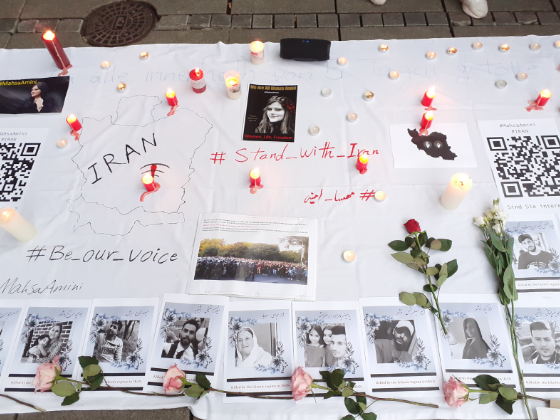Revolutionary protest in Iran
Death of Mahsa Amini sparks ‘riots’ over injustice in Iran.

The memory of Mahsa Amini is preserved in Stuttgrat, Germany.
October 14, 2022
22-year-old Mahsa Amini died mysteriously after being detained by police for wearing her headscarf improperly. Her death marks the beginning of human rights protests.
In Iran, head coverings are one of the many strict codes that women are under.
Headcoverings come in various forms, however the hijab is a head scarf that wraps around the head. It covers parts of the neck and chest, and leaves the face visible.
Under the Will of Allah, hijabs hold the purpose of obedience to their faith, protective shield against objectification, confidence in one’s appearance, and praise for fulfilling one’s duty to God with respect to modesty.
Since 1979, during the Islamic Revolution, it became law that girls who are nine years or older must wear a hijab.
The notion that hijabs hold modesty and chastity in The Holy Book of Quran, is the foundation for this law, however all women – regardless of faith – must cover their heads. Thus, many women are voicing that it should be a choice, rather than a law.
Even so, it is seen as a “crime” if a female over the age of 9 is seen without a hijab, and the punishments include arrest, a prison sentence, or a fine.
According to political scientist Ali Fatollah Najad, women seem to be the primary victim of the Islamic republic due to discrimination and the mandatory law that forces them to wear a hijab.
Mahsa Amini, the young woman who was arrested for having a loose hijab, had died in the custody of morality police, which has been the fuel to the revolutionary protests in Iran. Women have been burning their hijabs on the streets in protests throughout Iran.
The family of Amini and protesters are suspicious over her death, seeing as the police reported that Amini had a heart attack at the police station and later passed away after being in a coma for two days on Sept. 16, 2022.
Amini didn’t have any health concerns reported, and according to an eyewitness, Amini was being tortured in the van after her arrest and was hit in the head.
Thus, protesters have focused on the strict regulations of hijabs, and are also speaking up against the Islamic political system.
This has been the largest protests seen in Iran since 2019, as there have been discontent with the political, social, and economic systems.
Beyond burning hijabs and rallying, protesters have reportedly destroyed photos of Ayatollah Ali Khamenei, the Irianan Supreme Leader.
International officials have noted that the Irian government is an old system, and with a young society, their current form of government has a sense of dissatisfaction amongst its citizens.
Although protesters are mourning the death of Amini, they have also been fighting for their human rights and economic justice.
Throughout the progression of these recent protests, the Iranian government has completely shut off the internet. As a majority of their protests are organized online, it has been difficult for protestors to connect. Without the internet, the citizens of Iran are silenced from posting their message on social media.
Beyond this, the Iranian government is known for responding to protests through violence. Even so, Kareem Sajapur, a senior fellow at the Carnegie Endowment for International Peace, believes that there won’t be a concession after these protests, as there will likely be a brutal crackdown due to the four-decade history of the Iranian government brutally repressing citizens’ wishes.
Overall, the odds are against the protestors as the Iranian government has a regime that is armed, highly organized, powerful, and willing to kill at mass. As seen, protestors are without internet, unarmed, and leaderless.
Since the start of these protests in mid-September, there have been a reported 92 citizens killed.
The Iranian authorities have deemed these protests as “riots,” which has been blamed on the west for encouraging fury amongst protestors.
Since the death of Mahsa Amini, the United States has imposed sanctions on the Iranian morality police. In Australia protestors have gathered at the international match with Iran and Senegal. Additional protests have also been seen in the Middle East, Europe, and the United States.


